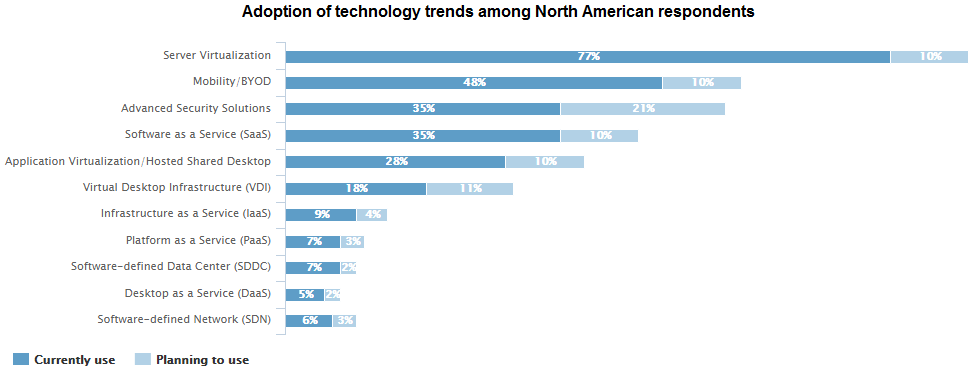Foreseeable challenges lie ahead for the many North American businesses that are pulling in record profits without boosting their IT departments’ budgets, according to the experts surveyed by Austin, Texas-based software developer and tech industry network Spiceworks.
Drawing from multiple sources, including a survey of more than 800 IT veterans, online discussions from the Spiceworks website, and real-time usage statistics from the company’s own Windows-based IT management platform, the 2016 State of IT report lays bare just how little the majority of tech budgets are budging this year, how much the lack of attention is straining the departments tasked with running them, and the consequences of neglect — for example, the security risks associated with relying on dead software such as Windows XP and Windows Server 2003, which more than 60 per cent of the companies surveyed apparently still do.
“Management is laser-focused on keeping costs low, but doesn’t quite get IT’s importance to the company… until something breaks,” the report’s authors wrote.
It’s worth noting that 24 per cent of the report’s respondents were from firms with between 100 and 249 employees, 20 per cent were from companies with between 50 and 99 employees, and 16 per cent were from businesses with fewer than 20. Only eight per cent of respondents were from enterprises with 1000 employees or more, and 59 per cent of respondents were from outside North America, though Spiceworks divided its information regionally wherever possible.
The company identified several trends based on the report’s data; the three most relevant are highlighted below.
Despite rising average annual company revenue, IT budgets remain relatively flat.
First, the good news: planned spending on IT hardware, software, and services is higher at North American companies than their European, Middle Eastern, and African counterparts, with the average western firm aiming to spend $327,798 in 2016, up from $303,879 in 2015, according to the study.
The bad news: The experts interviewed by Spiceworks say it isn’t enough.
Further, only 38 per cent of North American companies expect their IT budget to increase from 2015 to 2016, with larger companies (including enterprises with more than 2500 employees) more likely to increase their budgets than smaller ones, Spiceworks found.

And despite IT spending being relatively flat, 56 per cent of IT pros surveyed expect their company’s annual revenue to continue increasing in 2016, the study’s authors note.
IT departments don’t expect staff increases in 2016, which means they’ll need to keep doing more with less.
Only 32 per cent of companies surveyed in North America expect their IT staff to increase in 2016, while 62 per cent expect their numbers to decrease – bad news for many North American respondents, half of whom said their data and IT assets weren’t being adequately protected, Spiceworks found.
The same number of respondents said IT security wasn’t a top priority for their company in 2016, with few organizations conducting regular security audits, or updating their security practices to protect themselves against security breaches.
“In other words, there’s still a lot of room for improvement when it comes to securing IT environments from the threats lurking in the shadows, especially as news of hacks haunt the headlines,” the authors wrote.
Meanwhile, according to Spiceworks network data, Microsoft’s Windows 7 remains the most adopted OS, with 95 per cent of North American companies in the Spiceworks network still using it between July 2014 and July 2015.
In second place was Windows XP, which stopped receiving security updates from Microsoft two years ago, yet is still being used by a whopping 67 per cent of Spiceworks clients (a decrease of only seven per cent from 2014). Only 13 per cent of respondents had adopted Windows 8, a three per cent drop from 2014.
Spiceworks did not measure Windows 10’s penetration rate, though 47 per cent of respondents said they planned to allocate part of their budget for a Windows 10 upgrade.
Among enterprise clients, Windows Server 2003 is still being used by 60 per cent of North American companies, despite Microsoft ending support last July, though in a sign that fewer IT staff are using it, Spiceworks did report a penetration rate of 46 per cent for Windows Server 2012 – an 18 per cent increase over 2014.
Technology end-of-life (EOL) is expected to strongly influence investment in 2016.
What does convince companies to spend money on their IT departments? As with last year, technology end-of-life and company growth topped the list, according to Spiceworks, while only a quarter of respondents cited new tech features.
“This speaks to the motto of many companies: ‘If it ain’t broke, don’t fix it,'” the researchers wrote.

That said, almost a quarter of IT departments also plan to invest in advanced security this year, while application virtualization and various cloud-based services also ranked high on the list, they added.

